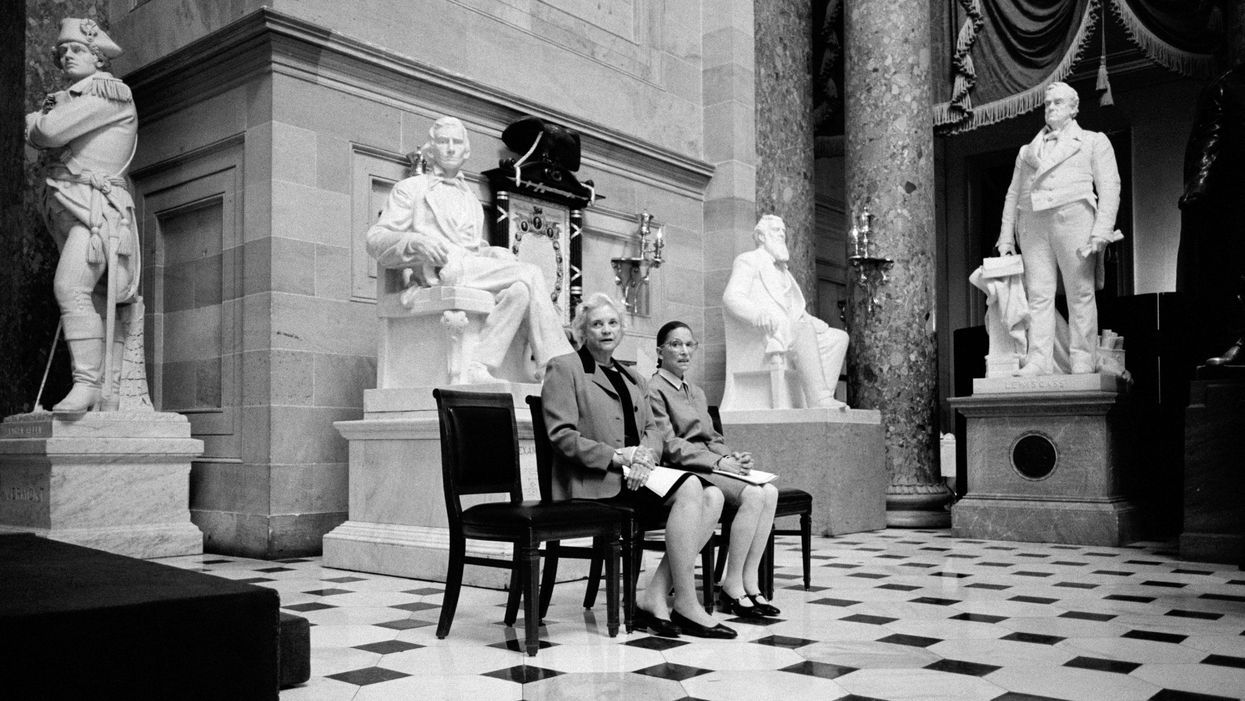Originally published by The 19th.
Sandra Day O’Connor and Ruth Bader Ginsburg — the first women to sit on the highest court in the country — are joining the relatively short list of women memorialized as sculptures at the U.S. Capitol. Bipartisan legislation to add statues of the two Supreme Court justices to the Capitol was spearheaded by women lawmakers, passed the Senate last December, passed the House at the end of March and signed by President Joe Biden on Wednesday.
“Justices Ruth Bader Ginsburg and Sandra Day O’Connor were trailblazers long before reaching the Supreme Court, opening doors for women at a time when so many insisted on keeping them closed,” Sen. Amy Klobuchar of Minnesota, a Democrat who introduced the legislation, told The 19th, after the bill was signed. “The Capitol is our most recognizable symbol of democracy, a place where people from across our country have their voices represented and heard. It is only fitting that we honor their remarkable lives and service to our country by establishing statues in the Capitol.”
Klobuchar said she was able to pass the news on to O’Connor’s son and Ginsburg’s daughter and looks forward to “welcoming them to the Capitol” to see their mothers’ lives commemorated. As it stands, only 14 of the more than 200 statues on the Capitol grounds are women, she added.
Born three years apart, O’Connor in 1930 and Ginsburg in 1933, the two women grew up on different sides of the country but went on to serve together on the Supreme Court for more than a decade. While the former was a lifelong Republican raised on a ranch in Arizona and the latter a liberal Democrat born and raised in Brooklyn, by the end of the 1950s, both women had earned law degrees from prestigious schools, ahead of the second-wave feminism movement that later swept the nation. O’Connor enrolled at Stanford University when she was only 16 and graduated six years later with an economics degree and a law degree. Ginsburg attended Cornell University, Harvard Law School and Columbia Law School, where she graduated first in her class.
More from The 19th
- Ruth Bader Ginsburg’s death continues to reverberate as abortion fight heats up
- Ketanji Brown Jackson will be the first Black woman justice. Here’s how she will change the Supreme Court.
Rep. Lois Frankel of Florida, co-chair of the Democratic women’s caucus, said Ginsburg and O’Connor do not deserve this honor “just because they’re women … The fact that they are the first two women to get to the Supreme Court is so significant because of what they had to do to get there.”
Early in her career, O’Connor was unable to find work as an attorney and ended up working in the San Mateo County District Attorney’s office in an unpaid position. She later served as an assistant attorney general for Arizona, a state senator and a trial court judge in the Arizona Court of Appeals. Ginsburg also struggled to find a law firm job after law school despite graduating top of her class. She went on to teach at Rutgers University Law School and later became the first woman tenured professor at her alma mater, Columbia Law School. She went on to serve as the director of the Women’s Rights Project of the ACLU, where she successfully argued six gender discrimination landmark cases before the Supreme Court, and later served as a judge on the United States Court of Appeals for the District of Columbia Circuit.
In her 2015 dual biography of the two women, Linda Hirshman described O’Connor and Ginsburg not as “soul sisters” but as “sisters in law.” Despite their differences, the two often found common ground when it came to advocating for women’s rights.
“Their presence in our Capitol is a reminder that a woman’s place is everywhere, something a Republican President saw in 1981 and a Democrat President saw in 1993,” bipartisan women’s caucus leadership said in a statement. “And we owe both Justices Sandra Day O’Connor and Ruth Bader Ginsburg a huge debt of gratitude.”
The last statue of a woman to find a permanent place in the Capitol building was Rosa Parks in 2013.
O’Connor would be the first person to have a statue built and placed in the Capitol in her honor in her lifetime. The Joint Committee of Congress on the Library will decide where the statues are placed, prioritizing areas near the Old Supreme Court Chamber. The cost of each cannot exceed $500,000, according to the legislation text. Frankel said the committee has two years to obtain the statues, in an artist selection process that includes candidates from underrepresented demographic groups.
The art collection in the Capitol — which includes 162 sculptures, some of which include multiple figures, according to the Architect of the Capitol — has sparked controversy in recent years. In 2020, the House voted 305 to 113 to pass legislation removing statues of Confederate figures and leaders from the building. The dissenters, all Republicans, argued that states should retain the right to decide which statues to contribute to the National Statuary Hall. The bill failed to receive enough Republican support in the Senate and some of the contested statues remain, including known slavery defenders and segregationists. Some states decided on their own accord to replace their contributions to Statuary Hall, which contains 100 statues, two from each state. Mississippi, for example, opted to remove the statue of Confederate General Robert E. Lee and replace it with one of Barbara Johns, a civil rights activist.
Republican Sens. Susan Collins of Maine and Lisa Murkowski of Alaska praised the new legislation. Murkowski said the two Supreme Court justices each “made a mark on American history,” and Collins added that the women deserve “fitting tributes to their invaluable contributions to our country.”
“There’s literally thousands of visitors that come into this Capitol — billions over the years — both from our country and across the world … I was a child a lot of years ago when I first came,” Frankel said. “But you think about children coming to Washington. It’s really a highlight, and just think about going through the Capitol and hardly seeing any women represented as people you admire, heroes and heroines. It’s pretty shocking.”
Klobuchar introduced similar legislation to erect a monument to honor Ginsburg several times — once in September 2020, again in March 2021 and most recently in December 2021 with the inclusion of O’Connor. But the bill did not successfully pass the House and Senate until this year. Frankel said hopes visitors and future generations will see the statues and continue to be inspired by the Supreme Court Justices.
“It’s about time,” Frankel said.





















